The Ultimate SEO Checklist for Your Shopify Store
There is no doubt that SEO (search engine optimisation), the practice of increasing your website’s presence in search engine results, is a huge component to success in the world of ecommerce.
In fact, studies show that 93% of online experiences now begin with a search engine and websites appearing on the first page of Google steal 95% of internet traffic.
Having a strong SEO foundation is therefore essential for getting ahead of the competition and boosting the revenue, reputation and overall success of your brand.
Written By
Esther Lowde

So how do you secure a top position on search result pages?
The good news is that, by hosting your store with Shopify, you are already one step ahead of the game. With its superfast 80 millisecond page response time, Shopify will take care of your speed-based SEO requirements automatically, and will also provide all the features you need to build a strong SEO foundation without the use of any costly plugins.
To get your store ranking highly for your target keywords, your goal is simply to ensure that your site provides an excellent user experience, is rich in relevant content and is formatted in a way that search engines can easily read and represent.
To help get you started, we have compiled this list of the most essential steps for building a strong SEO foundation, along with some strategic advice from our SEO Expert Paul Lavender, to get your store ranking at position one.
1. Do your research
The first step to building a good SEO foundation is to analyse your current ranking for keywords relevant to your Shopify store and products. This initial research is arguably the most important step of all in developing a strong SEO growth strategy as it will allow you to pinpoint popular words and phrases that you can then weave into your site’s content, allowing Google to rank you highly for relevant search terms.
Begin by mindmapping all the main search terms you feel your store could rank highly for. What do you think customers in search of products like yours would likely type into Google?
Next, use Google Webmaster Tools to identify the search volume of these keywords in your local area. The most highly searched terms should become your target keywords.
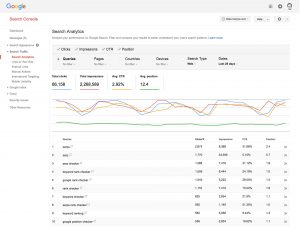
However, remember not to make your keyword focus too broad or too competitive. Hone in on terms which are popular but still specific to your business (e.g. ‘Fairtrade detox tea’ is preferable to just ‘tea’) and ensure that you have made note of enough words and phrases that you can weave them into your content naturally, as ‘keyword stuffing’ can actually prevent Google from recognising your content as valuable and deserving of a high rank position.
When researching keywords to focus on, you should also take note of where your competition are ranking in search engines and which terms they are ranking for. This will help you to gain inspiration for your own content, plan how to set your site apart from the crowd and avoid placing yourself in direct competition with larger businesses who are already set to win.
The SEO Expert says: “Ranking organic for smaller local areas is fairly straightforward, as simply having good foundation SEO will likely put you high in the rankings. However, high nationwide placements are harder to achieve, especially if you’re targeting a popular search term. For example, if you are selling trainers, the major players – such as Nike and Adidas – are going to be impossible to overtake. In this case, it is much more beneficial to concentrate instead on secondary keywords (such as “white trainers”).
Nevertheless, as long as you don’t expect to be above the big corporate companies, certain popular keywords are still worth targeting. Being at position 5 on the first page of Google will still get you hits, especially if your meta title and description entice people to visit your website.”
2. Implement technical SEO
Good SEO is a mixture of creating engaging content for users and making behind-the-scenes technical adjustments for search engine algorithms to understand. This means that half the battle lies simply in ensuring that the formatting of your site is thorough and precise.
A good place to begin is by perfecting your site’s meta titles and meta descriptions. These are the information given to users about your pages on the SERP (search engine results page) to summarise their content. They are also your chance to show potential customers why your site is worth clicking on.
A good meta title should be bold and engaging, while your meta description should be simple, snappy and unique to your brand, essentially outlining in one short paragraph the benefits of purchasing from your store. When writing meta descriptions for different pages of your site, remember to keep them original and avoid duplicating content, as this can count against you when it comes to raising your rank position on Google. 
In addition, you want to keep your page URL simple and user-friendly. Try to include a keyword within it and maximise its memorability by using underscores, dashes and long number combinations as scarcely as possible.
In order for Google to be able to read the content on your page fully, it is also crucial that you give all images on your site descriptive and appropriate ALT tags. Without this labelling, Google cannot understand what your image means and so cannot index the information on your pages properly.
All Shopify stores will also automatically generate an XML sitemap, which you should submit to search engines to allow them to crawl your store even more efficiently.
The SEO Expert says: “It is pointless even considering any off-site SEO methods (such as building your backlinks and social media presence) before completing a good SEO foundation.
This includes the correct placement and order of H1 and H2 (header 1 and header 2) tags. As a rule, H1 tags should be used first as page titles in order to inform Google what the page is about, while H2, H3 and H4 tags should follow on as subtitles.
In terms of assigning ALT tags to images, I like to tag images based on my target keywords. For example, if you were trying to sell pink hair bands, you would be wise to give your product images the ALT tag “pink-hair-bands-for-girls”. Where possible, add a relevant description within your back-end image settings as well.
Getting your meta descriptions and meta titles right is particularly important, as everyone wants to be ranked first on Google but this is no use if no one is then persuaded to click on your link! Your meta title should be strong, simple and easy to read. For example, a site I’ve recently built selling Nissan Navaras has the meta title ‘Nissan Navara Deals | Guaranteed Lowest UK Price’. This title matches the user’s search term and ends with a strong reason for the user to enter the site. It’s worth noting that Google have also recently increased the word limit for meta descriptions from 160 to 320 words. When writing yours, make sure to include your main target keywords (I usually aim for a minimum of two and a maximum of three) and end with a call to action such as ‘find your perfect…’ or ‘visit us online’.”
3. Enhance your website’s performance and usability
The golden rule of SEO is that your store needs to deliver an outstanding user experience. This means it needs to be fast, mobile friendly and ensure a quick and seamless journey to checkout.
Optimising website speed has always been crucial for running a successful ecommerce store, as studies have shown that just a 1 second delay in page load time can cause a 7% reduction in conversions. However, as Google has revealed that website speed is a key factor in its search ranking algorithms, the speed of your site should now also be an integral part of your SEO growth strategy. Thankfully, as Shopify is a cloud server, most of your speed-based SEO will already be taken care of. However, there are still a range of apps available, such as tag managers and image compression tools, that can help keep your website working as quickly as possible. We will explore these tools in more depth in the next step of this checklist.
Of course, you will also need to fix any glitches in your site (such as 404 error pages) to keep it running as smoothly and efficiently as possible. Both Screaming Frog and Google Search Console are great (and free!) tools for auditing your site and identifying any improvements that need to be made.
When maximising the usability of your Shopify store, it is also critical to consider the structure of your site. Your store should be clearly laid out and easy to navigate, requiring as few clicks as possible for the user to reach a product page after entering your site.
According to Google, more than 50% of all online searches are now made from mobile devices. As Google cater their SERP rankings to user preferences, your website therefore needs to look just as good and work just as well when accessed by mobile.
The SEO Expert says: “Nobody knows exactly what Google changes when they update their algorithm, but the talk for this year is on mobile versions of websites, with Google ranking websites based on their performance on mobiles and other devices. It is therefore more crucial than ever for your site to be fully responsive as part of good SEO.
It is also important to understand and reduce your bounce rate (the number of people who enter and leave a site without engaging with it at all) by improving the usability of your site. Remember that search engine placements are not static. Google want users to use their search engine, so will continue to rank popular and engaging sites more highly. A company may remain in position one for a particular keyword search for years, but if it develops a high bounce rate (of over 70%) it may quickly be overtaken on the SERP by a smaller but more user-friendly business.”
4. Make use of Shopify SEO apps and tools
As we approach the halfway point of this checklist, it should be clear that, from nailing your meta titles to refining your website layout, there are a huge number of factors that come into play in good SEO strategy development. With so many optimisations to consider, why not make the most of the wealth of Shopify tools and apps available and allow them to take care of some of the technicalities for you?
Shopify does offer its own SEO Meta Manager app, which we highly recommend for ecommerce managers looking for a simple way to manage basic aspects of their SEO such as their title and description editing, indexing and 404 error logging and repairs.
However, if you’re looking to create the most effective SEO strategy possible, there are also a huge range of other easy-to-use Shopify apps which can help you out with a range of different aspects of your store’s SEO management.
We asked Swanky’s own Digital Strategy Lead, Sean Clanchy, to share some of his favourites:
Tag managers:
Tag managers are extremely useful for optimising the speed of your website as they can be used to schedule when and where each element of a page loads, thus eliminating page delays and clunky loading screens. Although Shopify will automatically ensure that your site loads as quickly as possible, any apps you have working on the front end of your site will still slow it down considerably, and every second counts when it comes to earning your rank position on Google.
Google Tag Manager is one really useful (and free!) tag manager we recommend for Shopify store managers. Tealium is also extremely effective, although much more expensive than many others on the market as you are paying for enterprise-level deployment, configuration and support.
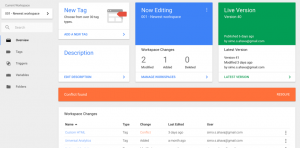
Image compression tools:
Another major improvement that you can easily make within Shopify is reducing the size of your images in order to reduce the total file weight of your site. Typically, we recommend compressing images by at least 30% but sometimes larger files can be downsized by as much as 90%, substantially improving the speed and usability of your store.
One of our favourite Shopify apps for compressing images is Crush.pics. As this app is fully automated, any new product images or promotional material you add to your store will be compressed for you by default.
However, to reduce code weight even further, we recommend running two or more image compression apps on your website simultaneously. Minifier is another great Shopify app to consider installing, as it not only compresses images but also automatically optimises their file names and ALT tags to allow search engines to read them more easily.
In addition to these apps, you can also use a website such as TinyPNG.com to compress images online for free.
Indexing tools:
Some elements of your site, such as written text, can be read automatically by search engines. However, some information, such as logos or images that have not been properly labelled, will not be deciphered by default. To ensure you are ranking for the right keywords, therefore, you need to let search engines know exactly what to index within your store. One great way of doing this is to use schema markup, which organises and tags the data on each page so that it can be better understood and represented by search engines.
One schema markup tool we recommend using is JSON-LD (JavaScript Object Notation for Linked Data), which will go through and label all of the elements on your pages so that search engines can recognise them properly. This tool is also very useful for highlighting the specific keywords you are looking to rank for on Google.

Customer review tools:
One of the easiest ways to implement excellent SEO is to generate rich and useful index content for Google by featuring customer reviews on your site.
Stamped is one of the top tools that we recommend for this as it is inexpensive but highly effective and a good fit for most general Shopify stores. However, if your store is specifically fashion-based, we particularly recommend installing Okendo as it allows users to leave multi-layered reviews in which they can review multiple aspects of a product (such as the fit, the quality and the colour) at once.
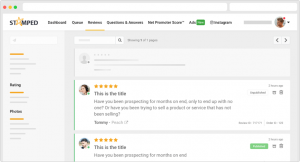
Organic keyword performance tracking tools:
Google Search Console is one of the best free tools available for tracking the organic keyword performance of your store. Traditionally, this tool simply enabled site owners to identify site errors that needed fixing. However, you can now also use Search Console to monitor how your store is ranking for a particular keyword (either globally or within a specific region) as well as how much organic traffic you are receiving.
You can also use it to identify popular search terms for your most profitable products, enabling you to begin writing targeted copy and improve your ranking for relevant keywords.
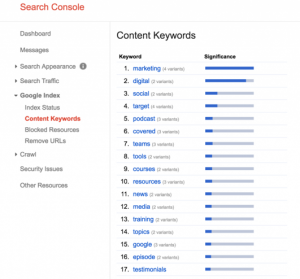
5. Create content that counts
While keyword optimisation is undoubtedly one of the most important aspects of SEO, it is very important to ensure that you are not simply ‘keyword stuffing’ or duplicating your own content in order to increase your word count as Google will generally pick up on this more artificial approach and will penalise you for it. Your focus should be on quality over quantity, with all of your written content carefully crafted for users and search engines alike to easily read and understand.
Keep your page titles and headers short so they are not cut off on results pages. Like your meta titles, they should be bold, inviting and should include just two or three of your target keywords.
Your product descriptions should ideally be around 300 words long, while the more informational pages on your site (such as your ‘About Us’ section) should contain a minimum of 500 words and feature a few of your target keywords woven in naturally when the context is fitting.
The SEO Expert says: “Content is king but make sure you’re not putting essays before products! Incorporate your target keywords but, as with all content on your site, avoid ‘keyword stuffing’.
Additionally, I recommend adding more text at the base of your pages, as although the majority of customers may not scroll down to read it, you’ll still be creating valuable content that search engines will recognise and index.”
6. Start blogging
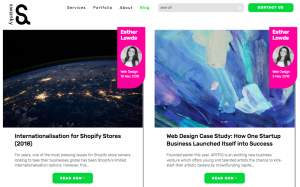
Another excellent way to keyword optimise is to create a company blog.
When done correctly, blogging can boost your organic ranking significantly as it gives you the opportunity to write targeted copy for popular search terms, allows you to build backlinks by creating shareable content and proves to Google that your business is frequently updated and fresh.
Begin by developing a content strategy for your blog. Within each post, focus on just one or two of the keywords you are trying to rank for and incorporate them naturally into your writing by covering topics that are current, stimulating and directly relevant to those search terms. This way, you will add variation and interest to your posts and ensure that you are regularly producing high-quality content which will be recognised and rewarded by Google.
In terms of the length of your blog posts, the longer the better. As long as the information you are providing is useful and relevant to your readers, there is no limit to how much content you can write.
7. Build inbound and internal links
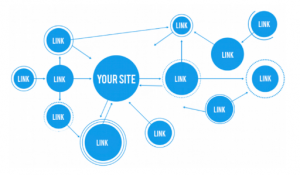
When it comes to successful off-page SEO, paying for Google Adwords and advertising from press may seem like an appealing quick fix. However, if you want to attain a rank position that is sustainable and long term, it is best to invest your time and resources into earning genuine backlinks from other sites.
Google views these backlinks as ‘votes’ that your site is valuable and interesting enough to be featured on its first pages, and the more reputable the website, the better (so avoid content farms at all costs!)
But how do you encourage high-quality blogs to link to your site? In short, by creating outstanding original content that other blogs will want to share. This is where running your own blog comes in handy, as you can use it as a platform for providing unique business insights into topics which have not yet been heavily written on.
You can also use your existing network of relationships to create opportunities for earning backlinks. For example, getting in touch with a company you have previously worked with to collaborate on an article or having a loyal customer write you a review on their blog are both great ways to show Google that your brand is trusted, active and worth showcasing on the first SERP.
Additionally, you can create your own backlinks by setting up accounts on reputable sites and leaving helpful comments and reviews.
You should also improve your SEO by creating internal links (which direct the user to another page within your website), as this allows link equity (ranking power) to flow throughout your entire site, increasing the ranking potential of each page.
The SEO Expert says: “When creating anchor links, I would recommend including your keywords within them; for example, “check out our latest ‘pink hair bands’”.
In terms of inbound links, you want to work on building links to your site from trusted websites, blogs and directories. This should be a careful and slow process, however, and I would advise staying away from unfamiliar companies who offer to do this.”
8. Integrate your social media
A strong social media presence is a fundamental part of good SEO practice as Google recognises when large numbers of real people are following and taking an interest in your brand and will raise your ranking accordingly. Creating interesting and engaging social media content also helps you build backlinks as external sites are encouraged to share your posts.
If you haven’t already, make sure to create accounts on Facebook, LinkedIn, Twitter, Instagram and Google+ and set up links to these channels on your Shopify site.
In particular, Google+ content gets indexed immediately, so sharing your blog posts on this platform is an easy way to ensure your brand will pop up more in search results.
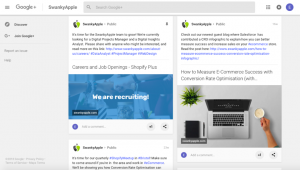
The SEO Expert says: “I use social media for two reasons. Firstly, to attract more users to visit a company’s website, and secondly, to help show search engines that a company is ‘active’.
Your social media posts should be 75% knowledge-based and only 25% targeted for purchase, as posting too many blatant advertisements will stop people wanting to follow your page.
Every post you make on social media should be linked back to the company’s main site, although it helps to change things up sometimes by linking to other pages besides your homepage.
I would also advise companies to branch out from their Facebook, Twitter and Instagram accounts by making use of other platforms (e.g. Houzz and Pinterest) as well.”
9. Track your SEO
After you have completed all of the above steps and built a solid SEO foundation for your store, how can you be sure all of your hard work is paying off?
We recommend tracking your progress using Google Analytics as this free platform allows you to measure key indicators of SEO success, including the total amount of organic traffic your store is receiving, how much of this traffic is coming from search engines and which of your pages are generating the most customer interest.
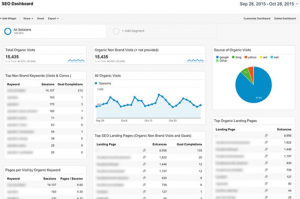
Keep in mind that maintaining good SEO is an ongoing process, and in order to reap the long term benefits you must commit to keeping up with what search engines are looking for and adapting your site structure and content output accordingly. Having a strong testing strategy in place is therefore just as much about identifying areas for improvement as it is about analysing the success of the techniques you have implemented so far.
The SEO Expert says: “I would recommend using multiple platforms when tracking SEO. For most smaller companies, Google Analytics is a fantastic tool that provides a lot of useful information on key areas such as bounce rate, time spent on site and page views. However, I also use Alexa and Voco Veritas as these platforms show more in-depth information about the performance of the websites I control, including any changes in keyword rankings and competitor placements.
I would also recommend installing Google Chrome’s META SEO inspector and SEOquake as these are useful tools for monitoring SEO as well.”
10. Consider consulting an SEO Expert
With such a wealth of information about good SEO practice freely available online, there is no reason why you cannot build a solid understanding of the fundamentals of SEO right from your own computer.
However, with Google’s algorithms constantly evolving, maintaining a strong SEO strategy can become a seriously time-consuming task, and attempting to rank highly for competitive keywords within an increasingly saturated market can leave you feeling confused about the best way to push your page ahead of the competition.
If you have the resources to invest in increasing the visibility of your store, you may therefore decide to hire an SEO firm to handle the process for you. These specialists will use their vast knowledge and experience to optimise both the structure and content of your website, giving you more time to focus on other aspects of your business management while the number of people visiting your store steadily rises.
If you do decide to consult an SEO expert, make sure you seek recommendations from others and take the time to research different agencies and the services they provide in order to determine which firm would be the most appropriate fit for your Shopify store.
The SEO Expert says: “The reason companies pay for SEO services is simple – to organically increase the number of users visiting their site. If you had the best physical shop to advertise your business, where would you want it to be? In a side alley where the odd person may stumble across it, or in the middle of a major shopping centre? SEO is a complex and gradual process but its benefits are long term.
For example, one company I worked with who have achieved great success after years of hard work is Gates and Fences UK, who currently have a number of position one keywords nationwide for searches related to gates. This top ranking was attained as economically as possible through ensuring a strong SEO foundation and implementing multiple off-site methods, whereas if they had looked at an average cost of 50p per click using Google Adwords, ranking highly for just one keyword would have cost them over £4500 per month.
While paying for advertising may be a useful short-term boost, correct SEO is therefore the most sustainable and cost-effective way of keeping your site high up in the rankings overall, and is well worth your investment.”
Time to get started!
After completing this checklist, you should be well on your way to increasing the visibility of your Shopify store on Google and boosting your sales significantly.
However, if you’re looking to go the extra mile and drive as much traffic as possible to your business, we do recommend consulting a certified professional, who will use their specialised knowledge, accuracy and experience to implement impeccable SEO to your site.
At Swanky, our expert team are happy to provide a range of professional SEO services to help you unlock your online store’s full ecommerce potential. Please don’t hesitate to get in touch with us if you would like to find out more.

